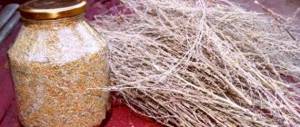Aloe vera flower appearance
Aloe vera is an unpretentious plant, and at the same time has excellent decorative qualities. These are the main reasons why indoor culture has become so widespread.
Aloe vera in the wild
The succulent is characterized by the presence of a low trunk, on which variegated and fleshy sword-shaped leaves are formed. The thick body of the leaf blades is filled with a yellow gel-like mass. The entire surface of the leaves is covered with spiny cilia, the edges are jagged. They can reach a length of 60 cm; they are formed in a spiral along the trunk, forming rosettes.
Note! The structure of aloe leaves is unusual. The internal cavity is divided into cells, in each of which the plant can retain moisture for a long time to maintain life.
In the wild, the ornamental crop produces red or yellow flowers. They are formed on a vertical peduncle, the height of which can reach almost 1 meter. It can also bloom when grown at home, but this is very rare.
Flower care at home
Aloe vera - what is it, what does the plant look like?
Before you find out what aloe cures, you need to familiarize yourself with the basic rules for caring for and maintaining an indoor pot at home. So, aloe vera is an unpretentious ornamental crop that does not have specific agrotechnical requirements. Like all representatives of succulents, it has good health.
Adapts quite quickly to any growing conditions. But in order for the culture not to survive, but to fully develop, it is recommended to create optimal conditions for it.
Aloe Vera in a decorative pot
Temperature and lighting
The quality of lighting plays, perhaps, one of the main roles in growing this succulent. Aloe is a very light-loving flower. With a lack of light, the crop may begin to stretch its leaves, so in autumn and winter it is recommended to additionally use additional light sources. It is recommended to place the pot with the plant on the windowsills on the south-east and south sides.
Important! With the arrival of spring, in order to avoid the formation of burns on the leaves, aloe is covered from the sun with gauze or tulle. The duration of the procedure is approximately 1 week.
In the summer months, to provide the optimal amount of ultraviolet radiation, it is better to move the plant to a balcony or veranda.
Air humidity and frequency of watering
Before you find out what you can do with aloe, you need to learn how to properly care for it. Otherwise, the benefits of using the juice and pulp of the leaves will be minimal. Watering should be moderate. Water the ornamental crop only as needed, when the soil surface begins to dry out. As soon as the sap flow stops, and also before winter, when the aloe enters a dormant period, the frequency of watering is reduced to once a week.
Dry air is best. The plant is not irrigated. If dust appears on the leaves, it is enough to remove it with a damp soft cloth.
Soil and fertilizers
For planting and replanting the “cactus”, use a special store-bought substrate. If you decide to prepare the soil yourself, then use leaf and turf soil and river sand. All components are mixed in equal proportions.
Complex mineral fertilizers for succulents
It is enough to apply fertilizers once a year in the spring. As fertilizers, it is better to use organic compounds that are designed specifically for succulents.
Dimensions of decorative pot
It is necessary to choose a flower pot not only by its external characteristics, but also by its volume. It is important that the volume of the root system of the flower is not much smaller. According to the observations of flower growers, it is better to use small containers.
The distance from the walls of the container to the roots should be no more than 3-4 cm. Before replanting, it is advisable to check whether the root system has grown in depth or breadth. This will determine what kind of container is needed - wide or deep.
Replanting and pruning
Pruning is necessary to renew the plant, its decorative qualities will improve, and more active growth will begin. The procedure should be carried out carefully so that the fleshy leaves are not damaged.
Note! Damaged leaves and excess shoots must be removed during the procedure.
Use a sharp and pre-disinfected instrument. The cut site is carefully treated with a disinfectant composition, for example, charcoal or activated charcoal.
Pruning medicinal and ornamental aloe vera
Sooner or later, any ornamental plant needs replanting. Aloe, of course, is no exception. It is recommended to replant young plants at intervals of a year, and adults once every 2-3 years. The most favorable time for the procedure is spring or summer.
Reproduction
Aloe vera can be propagated by seeds and cuttings. The second method is preferably used, since it takes less time and effort, and the result can be seen faster.
To sell, you need to separate the leaf cuttings from the stem and keep them in a dark room for 1-2 weeks to dry. This approach significantly increases the chances of successful rooting.
The lower part of the planting material is deepened into the previously prepared soil mixture by 3-4 cm, waiting for the first roots to appear. It is important to know that root formation occurs slowly in aloe. During this time, the leaf plate may begin to rot, so its condition must be constantly monitored.
Aloe vera cuttings
Diseases and pests
Like all representatives of succulents, aloe has good health. However, under unfavorable growing conditions and non-compliance with agrotechnical rules, the plant is susceptible to attacks by scale insects. Insects must be collected by hand.
Important! If you overwater, the root system of the plant may begin to rot.
There are also other problems when growing crops:
- If the tips of the leaves dry out, this means that the root system in the pot has grown greatly. The result is that the plant simply does not have enough nutrients contained in the soil.
- Curling leaves indicate that the crop needs more careful care. You need to start by removing contaminants from the surface of the sheet.
- If the leaves become watery and yellow tones predominate in color, then the soil is waterlogged; it is better to avoid watering for a while.
How to use?
Aloe can be used in a wide variety of applications. As already noted, in some countries it is even used in cooking, but for us this is not very common. But other areas of application are available.
It is worth noting that for the preparation of various remedies it is best to use the fleshiest lower leaves. And if the plant is not watered for several days, and then the leaves are placed in the refrigerator, then all the substances are activated, which will make the use of the plant more effective.
We offer several recipes:
- Some decide to get injections. But for injections, not ordinary aloe juice is used, but a special solution based on this plant in ampoules. Only a specialist can give injections, and they are effective for diseases of the digestive system, eyes, respiratory system, as well as for purulent inflammation.
- Prepare aloe juice. To do this, pick the lower leaves, put them in the refrigerator for a week, then chop them finely, put them in cheesecloth and squeeze out all the liquid. The prepared juice can be used for instillation into the nose for a runny nose, for treating wounds and burns, for rinsing in the treatment of sore throat (in this case, you need to dilute the juice with water in a 1:1 ratio).
- Alcohol tincture is great for colds and various infections. To prepare it, pick an aloe leaf, crush it or cut it and pour 100 milliliters of vodka or alcohol diluted with water (in a 1:1 ratio). Send the container to a dark, cool place for a week or two, then strain and take a teaspoon three times a day after meals with water.
- For stomach ulcers or to improve digestion for two to three weeks, take a teaspoon half an hour before meals three times a day.
- If you want to strengthen your immune system, then prepare this effective home remedy: take an aloe leaf, grind it in a blender or mince it, add a tablespoon of honey and leave the mixture for a day. Take a tablespoon in the morning and evening after meals.
- To treat cough, you can use a mixture of onion and aloe juices. Grind an aloe leaf and ¼ onion, squeeze the juice through gauze and take it three times a day, a teaspoon after meals.
Medicinal properties of the plant
Aloe flower - what it looks like, types and care
Many people wonder what can be made from aloe and how to use it. Thanks to its unique biochemical composition, the plant has many healing properties for the human body.
Types of medicinal aloe vera
Aloe vera contains a high concentration of B vitamins, folic and ascorbic acid, as well as magnesium, zinc, iron and potassium. Traditional medicine recipes have the following effects:
- tonic;
- pronounced disinfectant;
- removal/reduction of manifestations of irritation;
Preparations based on this succulent also prevent scarring of soft tissues and accelerate regeneration processes.
Important! If used incorrectly, a medicinal plant can cause harm. You should definitely consult a doctor.
The flower can cause harm in diseases of the liver, bladder and kidneys. It is contraindicated to use drugs based on it during pregnancy and lactation. It should be used with caution in case of possible allergic reactions.
How to use aloe for medicinal purposes at home
It is believed that the highest concentration of useful substances is contained in the lower leaves, the length of which reaches at least 15 cm. The peculiarity of use is as follows: the leaves are broken off exclusively at the base of the stem, the juice is used immediately.
Most often, the juice of the leaves is used to make homemade cosmetics. To treat skin diseases at home, it is most effective to use sabur or fresh juice.
For your information! Preservatives added to industrial aloe formulations reduce its effectiveness.
Harm and contraindications
Like any plant, aloe has some contraindications:
- Digestive disorders, some diseases of the digestive system (only when consumed orally).
- Oncological diseases (such a plant accelerates almost all processes in the body, so that the growth of cancer cells can begin).
- Epilepsy.
- You should be careful during pregnancy, especially in its early stages (there is a risk of miscarriage).
- Hypertensive patients should also exercise caution when ingesting it.
- You should not take risks with any bleeding, or if you are prone to it.
It is worth noting that allergic reactions may occur. And if it is abused and exceeds the recommended dosage, diarrhea may begin.












